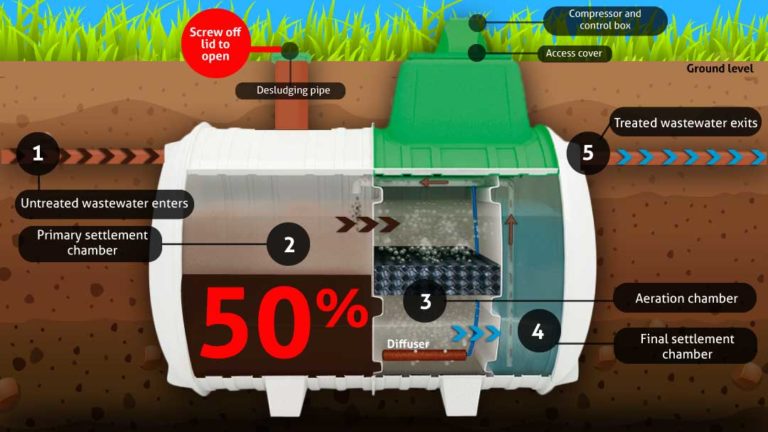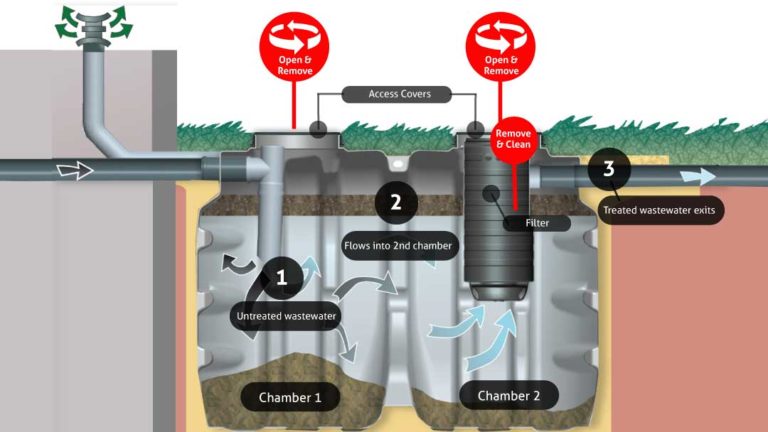SEWAGE TREATMENT
Desludge septic tank
OVERVIEW
Steps to Clean a Septic Tank
Schedule a licensed professional for desludging.
Ensure the tank is inspected for blockages or damage.
Avoid flushing non-biodegradables.
Repeat every 1–3 years, depending on usage.
Septic tanks as well as wastewater treatment plants all require desludging at some point.
It is necessary to desludge to ensure your wastewater treatment system is working without any issues and to prevent failures and pollution.
Click on your Tricel system:
If you have any questions, feel free to call us
cleaning your septic tank
- De-sludging is necessary at least once a year to prevent system failure as solids could rise to the height of the outlet pipe and then get carried along with the liquid into the percolation area. The trenches could then be blocked and cause flooding.
- The de-sludging of the Tricel Novo wastewater treatment plant or Tricel Vento septic tank is the responsibility of the homeowner.
- There is the potential danger of falling into the tank during de-sludging when manholes may be opened – take all necessary safety precautions when de-sludging.
- The access cover should never be left off unattended.
- Tricel recommends the use of a licensed company to carry out the de-sludging should be done with a vacuum tanker.
- The property owner has a legal responsibility to ensure that the system does not cause pollution, a health hazard or nuisance.
How to desludge: Tricel Novo sewage treatment plant
When should you desludge your sewage treatment plant?
CHECKING THE LEVEL OF SLUDGE
When the sludge is occupying 50% of the volume of the primary chamber de-sludging is required, this is necessary when the sludge is 700mm deep.
We would recommend you book a yearly service/maintenance during which the technician will check the sludge level and advise whether desludging if needed or not.
To book a service for your Tricel wastewater treatment solution, please contact us and we will refer you to one of our installers/maintenance companies.
THE GROUND
Do not allow machinery/traffic drive over the plant. Maintain a distance of at least 4 metres away from the covers of the Tricel Novo.
THE ACCESS
For the Novo sewage treatment plants, the access for desludging is through the desludging access cover (see image below). The section of the tank to empty is the primary settlement chamber. Note that in normal operation there is no need to empty the aeration chamber or the final settlement chamber.
The steps are as follows:
- Remove the de-sludging access covers.
- Empty the Tricel Novo using a vacuum tanker. Ensure the removal of the solids with the liquid.
- Take care not to damage the Tricel Novo with the hose of the vacuum tanker.
- Replace the de-sludging access cover securely.
Please note:
There is the potential danger of falling into the tank during de-sludging when manholes may be opened – take all necessary safety precautions when de-sludging.
The access cover should never be left off an unattended Tricel Novo.

FAQ – Desludging a Tricel Novo (SEWAGE TREATMENT PLANT)
SHOULD THE AIR BLOWER BE TURNED OFF DURING DESLUDGING?
No, there is no need to turn the air blower off during the desludging of the Tricel Novo.
WHAT TO DO AFTER DESLUDGING?
After emptying a Tricel Novo wastewater treatment plant, the primary settlement chamber must be filled back with water immediately until level with the aeration chamber.
WHAT’S THE FREQUENCY OF DESLUDGING?
When the sludge is occupying 50% of the volume of the primary chamber desludging is required, this is necessary when the sludge is 700mm deep.
For de-sludging periods, which depend on the occupancy of the dwelling, please refer to the table in section 3.1 ‘Dimensions’ in the manual. Carry out de-sludging with a vacuum tanker (Tricel recommends the use of a licensed company).
Please note that regular maintenance is also part of looking after your sewage treatment plant, check our Tricel Novo manual to see what is the recommended regular and annual maintenance.
How to desludge: Tricel Vento septic tank
When should you desludge your septic tank?
CHECKING THE LEVEL OF SLUDGE
Desludging of the Tricel Vento is recommended on a yearly basis. It is done to prevent solids rising to the height of the outlet pipe and being carried along with the liquid into the percolation trenches. This, in turn, can block the percolation area and can cause flooding.
GROUND
Do not let this equipment drive over the tank. Maintain a distance of at least 4 meters away from the covers of the tank.
Please note:
The access cover should never be left off while the unit is unattended.
De-sludging should never be carried out alone.
ACCESS
During the desludging or the septic tank emptying, both chamber 1 and chamber 2 should be emptied.
Steps to follow:
- Remove both access covers.
- Remove the filter.
- Empty the Tricel Vento septic tank using a vacuum tanker. Care must be taken not to damage the tank with the hose of the vacuum tanker.
- Ensure that all the solids are removed from the tank.
- Replace the de-sludging access cover securely.
- The filter of the septic tank also needs to be washed when removed during desludging.

faq – dESLUDGING A tRICEL vENTO (SEPTIC TANK)
WHAT TO DO AFTER DESLUDGING?
The septic tank/primary chamber must be refilled with fresh water after desludging.
WHAT IS THE FREQUENCY OF DESLUDGING A SEPTIC TANK TRICEL VENTO?
Desludging is recommended on a yearly basis. Depending on usage and house population, this period may vary. The minimum recommended desludging period is 1 year for all tank sizes.
For more information about the Tricel Vento septic tank, you can download the manual.
Puraflo maintenance
The Tricel Puraflo modules do not require “desludging” as such as the system is placed following a septic tank or wastewater treatment unit where the sludge would be kept. However, to ensure that the Tricel Puraflo system performs effectively, the septic tank/wastewater treatment plant must receive regular maintenance.
Installation with a septic tank + Tricel Puraflo
During the de-sludging of the septic tank, the effluent filter at the outlet of the septic tank should be removed from its housing and hosed down to remove any materials which may result in blockage (secondary treatment only).
The Puraflo, like any other system, does require some maintenance, we recommend an annual service.
To book a service, contact us & we will refer you to one of our installers/maintenance companies.
If you would like more information about the Puraflo, please check out the Puraflo Operation and Maintenance Manual.
Key features

Cost-Effective
Operating costs are reduced to a minimum.

quality
Sewage treatment plants are extremely reliable and durable as they are made out of long-lasting materials.

Certified
All Tricel Novo sewage treatment plants are tested to the highest quality standards and are EU Certified to EN12566-3